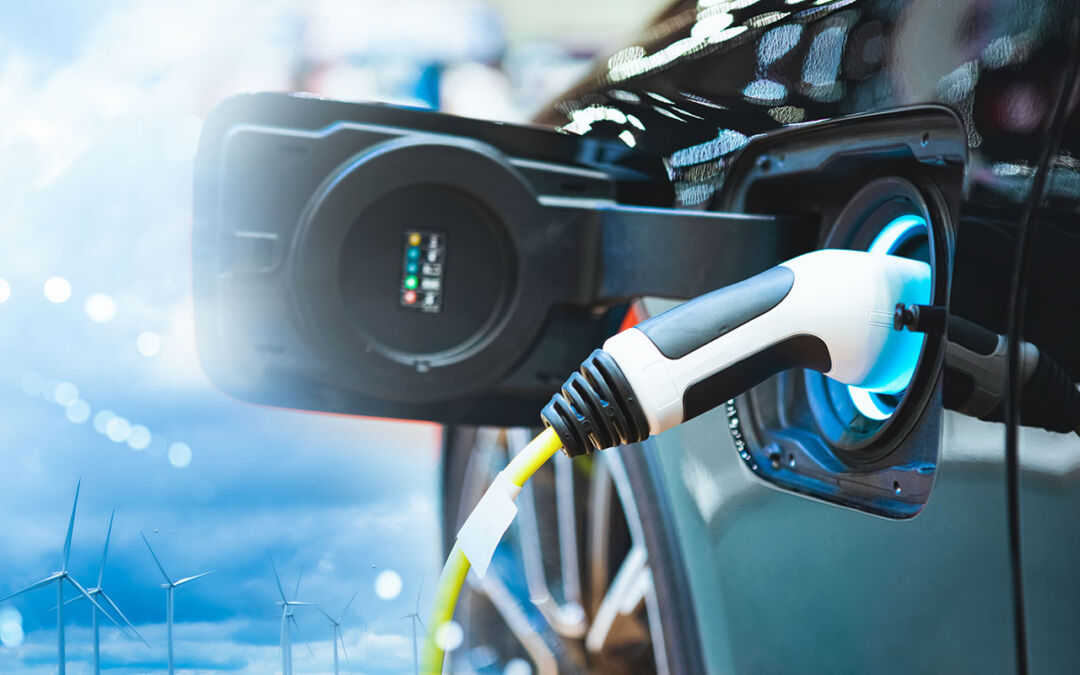How the Infrastructure Investment and Jobs Act of 2021 is promoting sustainable U.S. economic growth and mitigating climate change

In an issue brief earlier this year, Equitable Growth discussed how the Infrastructure Investment and Jobs Act of 2021 rests on sound economic principles and analyzed the ways that its $1.2 trillion in government investments helps address urgent and immediate economic needs. But it’s also crucial to reflect on the ways the law establishes a path for addressing long-term economic and climate needs.
The 1-year anniversary of the Infrastructure Investment and Jobs Act this week is a good time to do so. Why? Because the investments set in motion by the law are beginning to bear fruit. These investments are now setting a path for long-term economic growth while addressing the risks of climate change.
This column examines how the Infrastructure Investment and Jobs Act is helping to build the foundations for addressing persistent trends constricting strong, sustainable, and broadly shared economic growth, while also addressing the consequences of climate change over the long term. Fundamentally, long-term growth cannot exist without addressing the consequences of climate change: Long-term economic growth and runaway climate change are mutually antagonistic.
The Infrastructure Investment and Jobs Act addresses long-term growth
Lagging U.S. economic growth is a problem that has been identified by economists over many decades, though perspectives have varied on the precise causes. One prominent recent explanation, beginning in the 2010s, is “secular stagnation.” This phrase refers to the phenomenon of a chronic excess of savings, relative to investment, in the economy, resulting in downward pressure on real interest rates, low inflation, and weakened demand, leading to slow growth.
There was significant debate about secular stagnation during this time, yet slower growth and weakened aggregate demand, relative to the U.S. economy’s productive capacity, were nevertheless well-documented prior to the start of the COVID-19 pandemic in early 2020 and the resulting recession. There is still an ongoing debate about secular stagnation in light of the strong U.S. economic recovery from the short-but-sharp COVID-19 recession, yet the structural factors contributing to constricted growth have not disappeared.
In short, even if the U.S. economy is not currently facing secular stagnation, the evidence demonstrating that decades-long trends in inequality are a drag on growth is nevertheless well-documented.
There are several ways that economic inequality drags down economic growth. The primary way is through distorting demand and dulling the private sector’s incentives to invest. That is, growing economic inequality destabilizes spending because more consumers either don’t have enough earnings to spend or are taking on too much debt to buy what they need. As a result, businesses are reluctant to invest.
The $1.2 trillion in investments sparked by Infrastructure Investment and Jobs Act address inequality’s effects on growth in two ways. The first, discussed in the issue brief mentioned above, is by prioritizing equitable growth head-on through its emphasis on unionization and racial equity. The second is by addressing diminished public investments head-on—the subject of this column.
Since the 1980s, firms have steadily held onto cash at historically high rates. Some estimates indicate aggregate cash and marketable securities positions of close to $4 trillion for nonfinancial firms, which is almost triple what it was 20 years ago. In what they term the “savings glut of the rich,” economists Atif Mian and Ludwig Straub of Princeton University and Amir Sufi of the University of Chicago Booth School of Business note that the rise in savings by the top 1 percent of the income or wealth distribution since the 1980s has been substantial, but it has not boosted investment.
In fact, Mian, Straub, and Sufi also note the average annual savings by the top 1 percent of the income or wealth distribution have been larger than average annual net domestic investment since 2000. In contrast, savings by the bottom 90 percent of the income or wealth distributions have fallen significantly since the 1980s, driven by an increase in their borrowing and a decline in their accumulation of financial assets.
Indeed, the co-authors find that almost two-thirds of the rise in financial asset accumulation of the top 1 percent of the wealth distribution since the 1980s has been due to a rise in the accumulation of claims on U.S. government and household debt by the most exceedingly wealthy. Investment has been correspondingly lagging.
Direct public investments are also at historical lows. Federal investments today stand at roughly 1.5 percent of Gross Domestic Product, their lowest level since 1947. The decline in investments at the state and local levels has been less dramatic but still significant. Spending by state and local governments on all types of capital dropped from its high of 3 percent of GDP in the late 1960s to less than 2 percent now.
The $1.2 trillion in investments provided by the Infrastructure Investment and Jobs Act enable the kind of large-scale projects necessary to untether constricted economic growth that has resulted from persistent public-sector disinvestment. What’s more, public investments of this significant size can pave the way for private-sector innovation and growth. This is especially the case for the investments enacted by the law for innovation and technology, such as the Public Transportation Innovation program, which includes construction technologies such as 3D modeling and digital project management platforms that can innovate supply chains and reduce environmental waste.
In the past, of course, many of the biggest advances in U.S. economic productivity, innovation, and technological capacity have been the result of government action. Consider, for example, the internet, which was originally a project funded by the U.S. Department of Defense. Likewise, NASA maintains a catalogue of thousands of technologies that became commercial products. The Apollo Space program helped accelerate innovation and create technologies that have widespread use and application today, such as the integrated circuit, which is the basis for computer chips today.
In her book, The Entrepreneurial State: Debunking Public vs. Private Sector Myths, University College London economist Mariana Mazzucato highlights the role of government investment at the heart of major technological breakthroughs, noting that Apple Inc. and other successful private companies owe much of their value to government-supported research and development. Nearly all the technologies in the iPhone, for example—including GPS navigation, voice recognition, and touchscreen capabilities—were developed through government investments, while Alphabet Inc.’s Google search engine algorithm was funded by the National Science Foundation.
There is certainly room for increasing these types of public investments. Funding for the National Institutes of Health and National Science Foundation, for example, is well below previous highs. In a recent working paper, Pierre Azoulay of the Massachusetts Institute of Technology and his co-authors find that increased funding for the National Institutes of Health would spur the development of private-sector patents. Specifically, they find that a $10 million increase in funding for an area would lead to 2.3 additional patents. Put another away, the co-authors estimate one private-sector patent would be generated for every two to three NIH grants.
Infrastructure investments such as the ones made in the Infrastructure Investment and Jobs Act are especially complementary to private-sector economic activity. One recent meta-analysis examined the rate of return on infrastructure investments, finding that each $100 spent on infrastructure boosts private-sector output by a median of $13, and $17 on average in the long run.
Infrastructure investments also have large multiplier effects—that is, a proportionally higher increase in Gross Domestic Product for every dollar increase in investment—especially when compared to other fiscal interventions, such as tax cuts. Research by Sylvain Leduc and Daniel Wilson at the Federal Reserve Bank of San Francisco suggests investments in transportation infrastructure have particularly large multiplier effects and can be as high 3 to 7 times after 6 to 8 years.
Moreover, the latest projections by the Congressional Budget Office suggest that the Infrastructure Investment and Jobs Act will have positive effects on GDP and productivity over the next decade. These CBO projections are telling because of the CBO’s high degree of uncertainty and undue pessimism about the U.S. economy’s capacity in recent years.
The Infrastructure Investment and Jobs Act addresses the consequences of climate change
The Infrastructure Investment and Jobs Act also provides a path for long-term, sustainable growth by making key investments in environmental and energy infrastructure. By doing so, the legislation helps to mitigate climate change over the long term, especially when coupled with the recently enacted Inflation Reduction Act of 2022.
One example of the how these two laws complement each other with climate investments is in the transportation sector, which accounts for 27 percent of greenhouse gas emissions. The Inflation Reduction Act establishes a tax credit of $7,500 for new electric vehicles and $4,000 for used ones, and allows for the tax credits to be transferred to auto dealers at the point of sale. This accelerated deployment of electric vehicles can reduce emissions as much as 280 million metric tons by 2030, or about 28 percent of the total emissions cut by the Inflation Reduction Act during that time period, according to some projections.
The Inflation Reduction Act also provides $2 billion in grants to incentivize domestic manufacturing. Correspondingly, the Infrastructure Investment and Jobs Act provides $7.5 billion to build out EV charging infrastructure, thereby making more accessible the charging of these electric vehicles. Incentives for coordinated technology deployment such as these are doubly effective because they both eliminate wasted investments in incompatible technologies and accelerate adoption of new technologies.
To be sure, the precise impact of these investments is contingent on the ways state and local governments implement them. An analysis by the Georgetown Climate Center estimates the impact of the $600 billion that the Infrastructure Investment and Jobs Act provided for surface transportation investments. The analysis finds that these investments boast the potential to cut emissions by 1.6 percent below their projected baseline emissions within just 5 years, which is about the equivalent of emissions from 4.5 million passenger vehicles. But the analysis also estimates this scenario based on policymakers prioritizing low-carbon strategies, such as the electrification of transit and school buses, within the portfolio of transportation investments.
If policymakers instead prioritize high-carbon strategies, such as highway expansions, then greenhouse emissions may trend upward overtime. And there are already examples of state and local governments implementing low-carbon strategies, such as Colorado incorporating funding into the state’s greenhouse gas emissions reduction plan.
The estimated hundreds of thousands of green jobs created by both the Infrastructure Investment and Jobs Act and the Inflation Reduction Act are crucial for creating more equitable economic growth. In a recent paper, E. Mark Curtis of Wake Forest University and Ioana Marinescu of the University of Pennsylvania develop a measure of green jobs—specifically, occupations in the solar and wind energy fields—and find these jobs benefit workers. Specifically, they find that green jobs tend to be in occupations that are about 21 percent higher paying than the average in other industries—including fossil-fuel extraction—with the pay premium being even greater for green jobs with low educational requirements. They also find that green jobs in general have the same educational requirements as other jobs, with about 40 percent requiring only a high school degree.
Ultimately, long-term economic growth is impossible without addressing the consequences of climate change. One recent study by economists Gregory Casey and Matthew Gibson at Williams College and Stephie Fried at Arizona State University’s W.P. Carey School of Business finds that existing models used in the research that evaluates the economic costs of climate change may be underestimating the damages. Instead, their model suggests climate change disproportionately affects investment goods, or goods used in the production chain, and thus have longer-term ill effects on economic growth and productivity.
The Infrastructure Investment and Jobs Act is helping to set in motion some of the investments necessary to combat climate change over the long term. But more legislative action is needed to complement these investments. This will require comprehensive climate action and reevaluating assumptions about what makes the U.S. economy grow.







